The Bulldozer Review: AMD FX-8150 Tested
by Anand Lal Shimpi on October 12, 2011 1:27 AM ESTGaming Performance
AMD clearly states in its reviewer's guide that CPU bound gaming performance isn't going to be a strong point of the FX architecture, likely due to its poor single threaded performance. However it is useful to look at both CPU and GPU bound scenarios to paint an accurate picture of how well a CPU handles game workloads, as well as what sort of performance you can expect in present day titles.
Civilization V
Civ V's lateGameView benchmark presents us with two separate scores: average frame rate for the entire test as well as a no-render score that only looks at CPU performance.
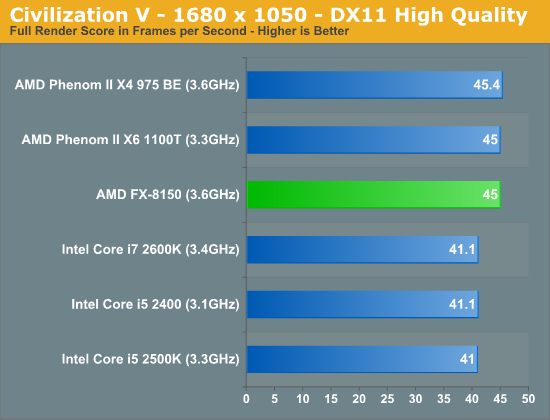
While we're GPU bound in the full render score, AMD's platform appears to have a bit of an advantage here. We've seen this in the past where one platform will hold an advantage over another in a GPU bound scenario and it's always tough to explain. Within each family however there is no advantage to a faster CPU, everything is just GPU bound.
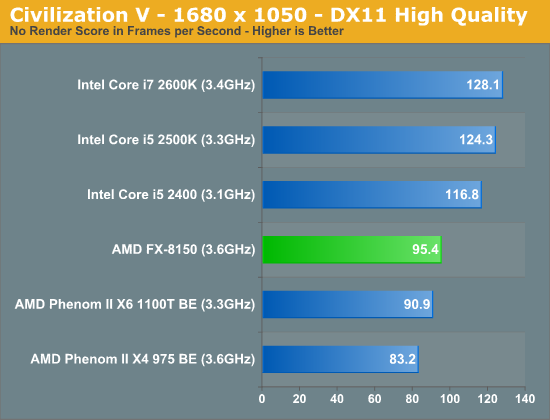
Looking at the no render score, the CPU standings are pretty much as we'd expect. The FX-8150 is thankfully a bit faster than its predecessors, but it still falls behind Sandy Bridge.
Crysis: Warhead
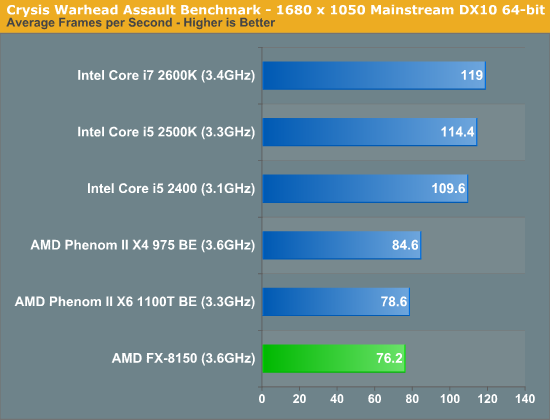
In CPU bound environments in Crysis Warhead, the FX-8150 is actually slower than the old Phenom II. Sandy Bridge continues to be far ahead.
Dawn of War II
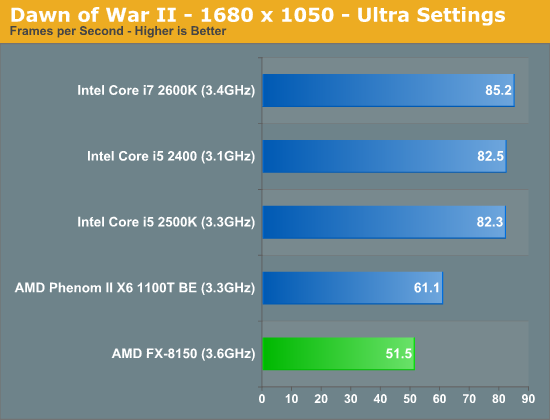
We see similar results under Dawn of War II. Lightly threaded performance is simply not a strength of AMD's FX series, and as a result even the old Phenom II X6 pulls ahead.
DiRT 3
We ran two DiRT 3 benchmarks to get an idea for CPU bound and GPU bound performance. First the CPU bound settings:
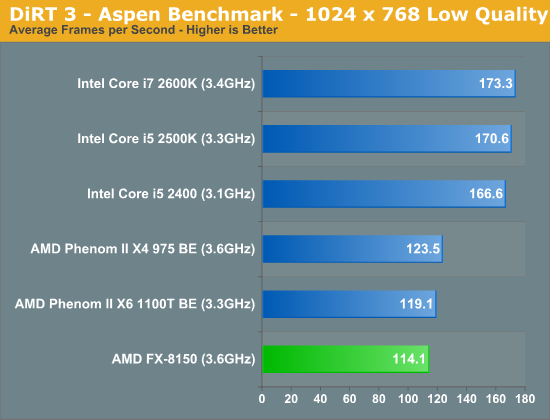
The FX-8150 doesn't do so well here, again falling behind the Phenom IIs. Under more real world GPU bound settings however, Bulldozer looks just fine:
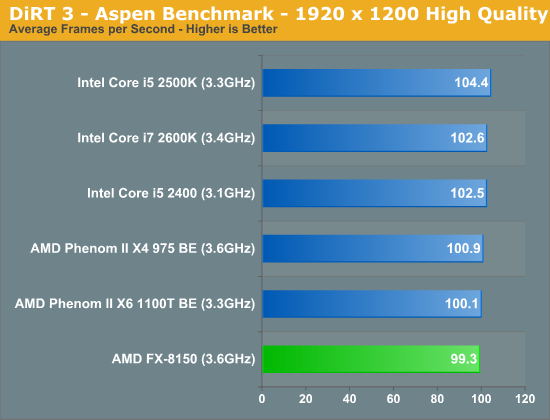
Dragon Age
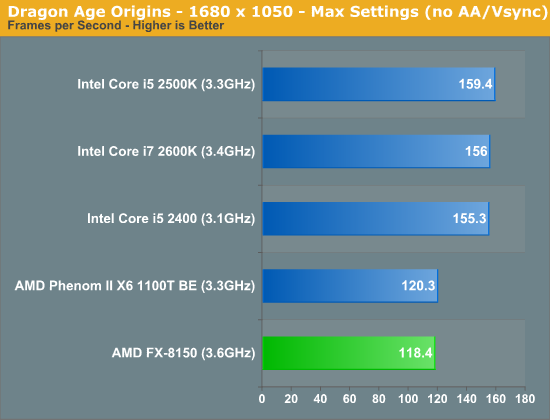
Dragon Age is another CPU bound title, here the FX-8150 falls behind once again.
Metro 2033
Metro 2033 is pretty rough even at lower resolutions, but with more of a GPU bottleneck the FX-8150 equals the performance of the 2500K:
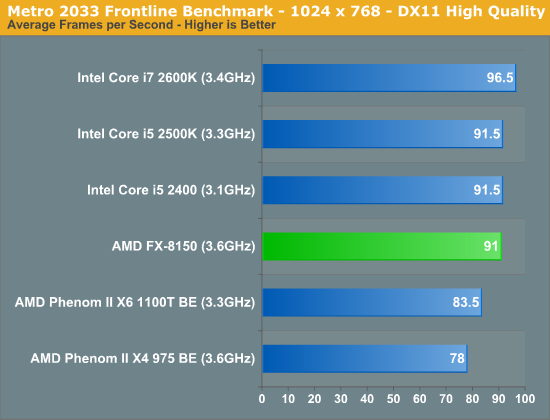
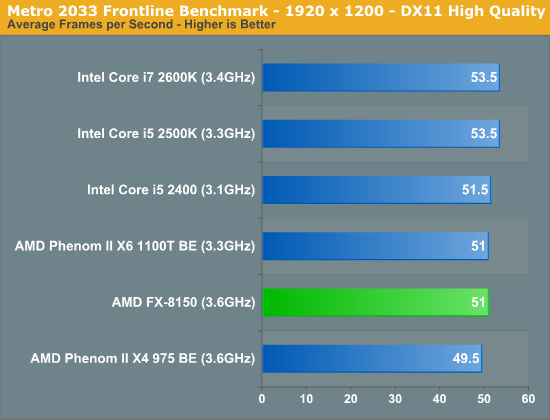
Rage vt_benchmark
While id's long awaited Rage title doesn't exactly have the best benchmarking abilities, there is one unique aspect of the game that we can test: Megatexture. Megatexture works by dynamically taking texture data from disk and constructing texture tiles for the engine to use, a major component for allowing id's developers to uniquely texture the game world. However because of the heavy use of unique textures (id says the original game assets are over 1TB), id needed to get creative on compressing the game's textures to make them fit within the roughly 20GB the game was allotted.
The result is that Rage doesn't store textures in a GPU-usable format such as DXTC/S3TC, instead storing them in an even more compressed format (JPEG XR) as S3TC maxes out at a 6:1 compression ratio. As a consequence whenever you load a texture, Rage needs to transcode the texture from its storage codec to S3TC on the fly. This is a constant process throughout the entire game and this transcoding is a significant burden on the CPU.
The Benchmark: vt_benchmark flushes the transcoded texture cache and then times how long it takes to transcode all the textures needed for the current scene, from 1 thread to X threads. Thus when you run vt_benchmark 8, for example, it will benchmark from 1 to 8 threads (the default appears to depend on the CPU you have). Since transcoding is done by the CPU this is a pure CPU benchmark. I present the best case transcode time at the maximum number of concurrent threads each CPU can handle:
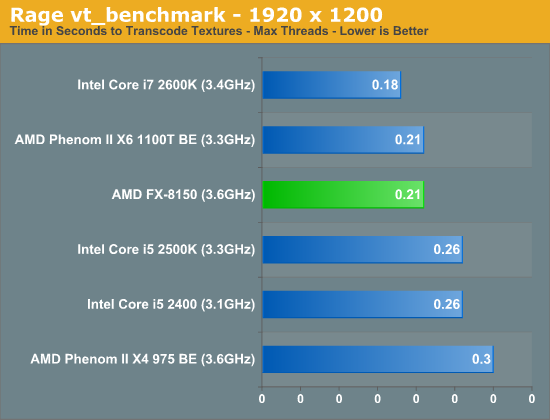
The FX-8150 does very well here, but so does the Phenom II X6 1100T. Both are faster than Intel's 2500K, but not quite as good as the 2600K. If you want to see how performance scales with thread count, check out the chart below:
Starcraft 2

Starcraft 2 has traditionally done very well on Intel architectures and Bulldozer is no exception to that rule.
World of Warcraft
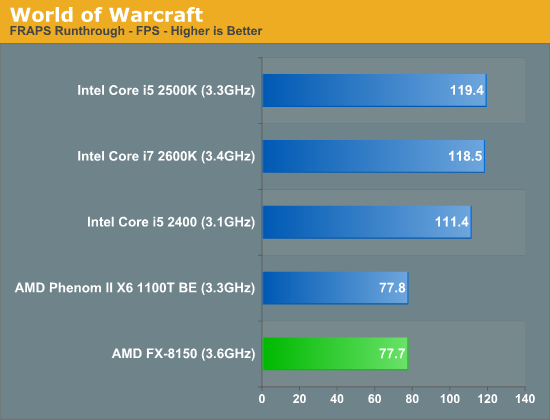


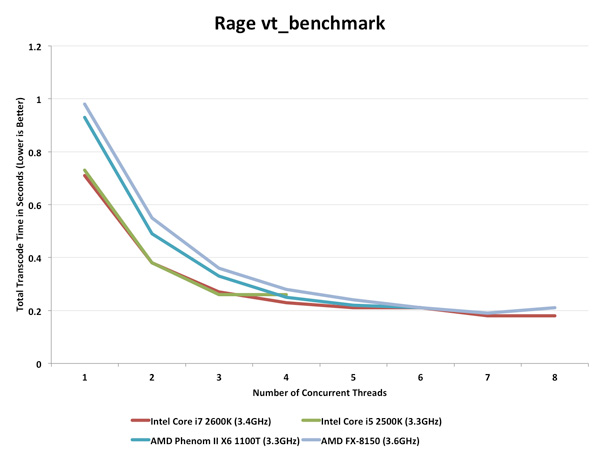








430 Comments
View All Comments
ThaHeretic - Saturday, October 15, 2011 - link
Here's something for a compile test: build the Linux kernel. Something people actually care about.Loki726 - Monday, October 31, 2011 - link
The linux kernel is more or less straight C with a little assembly; it is much easier on a compiler frontend and more likely to stress the backend optimizers and code generators.Chromium is much more representative of a modern C++ codebase. At least, it is more relevant to me.
nyran125 - Saturday, October 15, 2011 - link
Whats the point in having 8 cores, if its not even as fast as an intel 4 core and you get better performance overall with intel.. Heres the BIG reality, the high end 8 core is not that much cheaper than a 2600K. Liek $20-60 MAX> Youd be crazy to buy an 8 core for the same price as an intel 2600K...LIKE MAD!!!
Fiontar - Saturday, October 15, 2011 - link
Well, these numbers are pretty dismal all around. Maybe as the architecture and the process mature, this design will start to shine, but for the first generation, the results are very disappointing.As someone who is running a Phenom II X6 at a non-turbo core 4.0 Ghz, air cooled, I just don't see why I would want to upgrade. If I got lucky and got a BD overclock to 4.6 Ghz, I might get a single digit % increase in performance over my Phenom II X6, which is not worth the cost or effort.
I guess on the plus side, my Phenom II was a good upgrade investment. Unless I'm tempted to upgrade to an Intel set up in the near future, I think I can expect to get another year or two from my Phenom II before I start to see upgrade options that make sense. (I usually wait to upgrade my CPU until I can expect about a 40% increase in performance over my current system at a reasonable price).
I hope AMD is able to remain competitive with NVidia in the GPU space, because they just aren't making it in the CPU space.
BTW, if the BD can reliably be overclocked to to 4.5Ghz+, why are they only selling them at 3.3 Ghz? I'm guessing because the added power requirements then make them look bad on power consumption and performance per watt, which seems to be trumping pure performance as a goal for their CPU releases.
Fiontar - Saturday, October 15, 2011 - link
A big thumbs down to Anand for not posting any of the over-clock benchmarks. He ran them, why not include them in the review?With the BD running at an air cooled 4.5 Ghz, or a water cooled 5.0 Ghz, both a significant boost over the default clock speed, the OC benchmarks are more important to a lot of enthusiasts than the base numbers. In the article you say you ran the benchmarks on the OC part, why didn't you include them in your charts? Or at least some details in the section of the article on the Over-clock? You tell us how high you managed to over-clock the BD and under what conditions, but you gave us zero input on the payoff!
Oscarcharliezulu - Saturday, October 15, 2011 - link
...was going to upgrade my old amd3 system to a BD, just a dev box, but I think a phenom x6 or 955 will be just fine. Bit sad too.nhenk--1 - Sunday, October 16, 2011 - link
I think Anand hit the nail on the head mentioning that clock frequency is the major limitation of this chip. AMD even stated that they were targeting a 30% frequency boost. A 30% frequency increase over a 3.2 GHz Phenom II (AM3 launch frequency i think) would be 4.2 GHz, 17% faster than the 3.6 GHz 8150.If AMD really did make this chip to scale linearly to frequency increases, and you add 17% performance to any of the benchmarks, BD would roughly match the i7. This was probably the initial intention at AMD. Instead the gigantic die, and limitations of 32nm geometries shot heat and power through the roof, and that extra 17% is simply out of reach.
I am an AMD fan, but at this point we have to accept that we (consumers) are not a priority. AMD has been bleeding share in the server space where margins are high, and where this chip will probably do quite well. We bashed Barcelona at release too (I was still dumb enough to buy one), but it was a relative success in the server market.
AMD needs to secure its spot in the server space if it wants to survive long term. 5 years from now we will all be connecting to iCloud with our ARM powered Macbook Vapor thin client laptops, and a server will do all of the processing for us. I will probably shed a tear when that happens, I like building PCs. Maybe I'll start building my own dedicated servers.
The review looked fair to me, seems like Anand is trying very hard to be objective.
neotiger - Monday, October 17, 2011 - link
"server space where margins are high, and where this chip will probably do quite well."I don't see how Bulldozer could possibly do well in the server space. Did you see the numbers on power consumption? Yikes.
For servers power consumption is far more important than it is in the consumer space. And BD draws about TWICE as much power as Sandy Bridge does while performs worse.
BD is going to fail worse in the server space than it will in the consumer space.
silverblue - Monday, October 17, 2011 - link
I'm not sure that I agree.For a start, you're far more likely to see heavily threaded workloads on servers than in the consumer space. Bulldozer does far better here than with lightly threaded workloads and even the 8150 often exceeds the i7-2600K under such conditions, so the potential is there for it to be a monster in the server space. Secondly, if Interlagos noticably improves performance over Magny Cours then coupled with the fact that you only need the Interlagos CPU to pop into your G34 system means this should be an upgrade. Finally, power consumption is only really an issue with Bulldozer when you're overclocking. Sure, Zambezi is a hungrier chip, but remember that it's got a hell of a lot more cache and execution hardware under the bonnet. Under the right circumstances, it should crush Thuban, though admittedly we expected more than just "under the right circumstances".
I know very little about servers (obviously), however I am looking forward to Johan's review; it'd be good to see this thing perform to its strengths.
neotiger - Monday, October 17, 2011 - link
First, in the server space BD isn't competing with i7-2600K. You have to remember that all the current Sandy Bridge i7 waste a big chunk of silicon real estate on GPU, which is useless in servers. In 3 weeks Intel is releasing the 6 core version of SB, essentially take the transistors that have been used for GPU and turn them into 2 extra cores.Even in highly threaded workloads 8150 performs more or less the same level as i7-2600K. In 3 weeks SB will increase threaded performance by 50% (going from 4 cores to 6). Once again the performance gap between SB and BD will be huge, in both single-threaded and multi-threaded workloads.
Second, BD draws much higher power than SB even in stock frequency. This is born out by the benchmark data in the article.